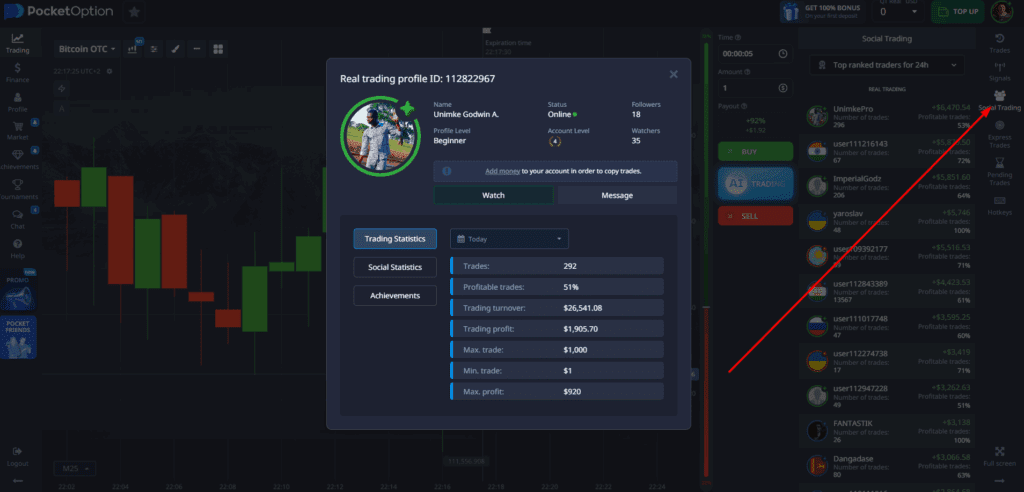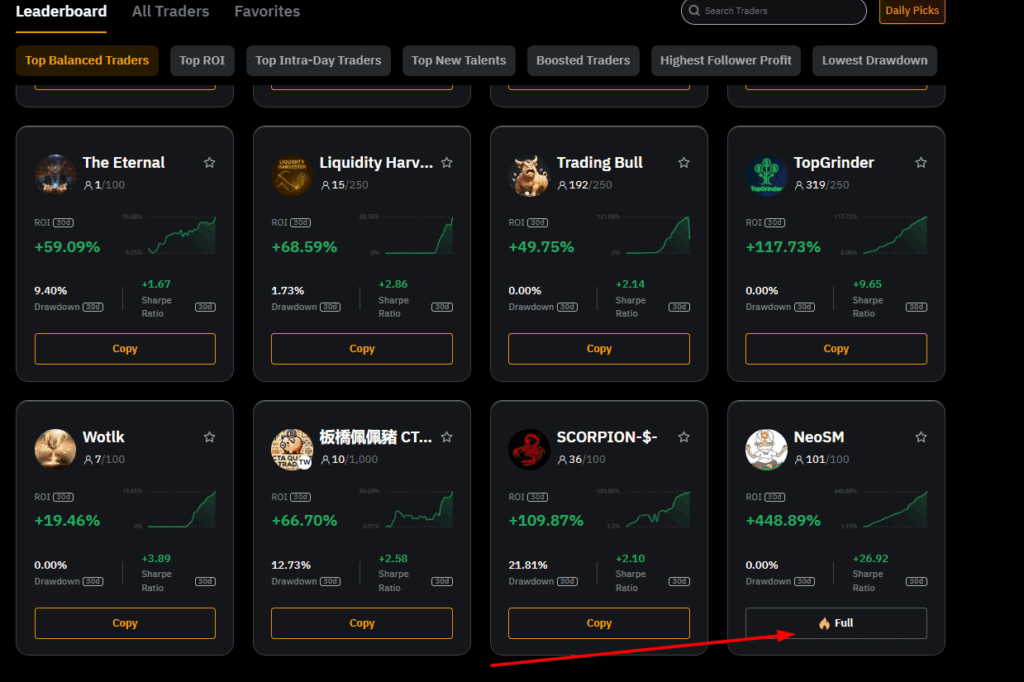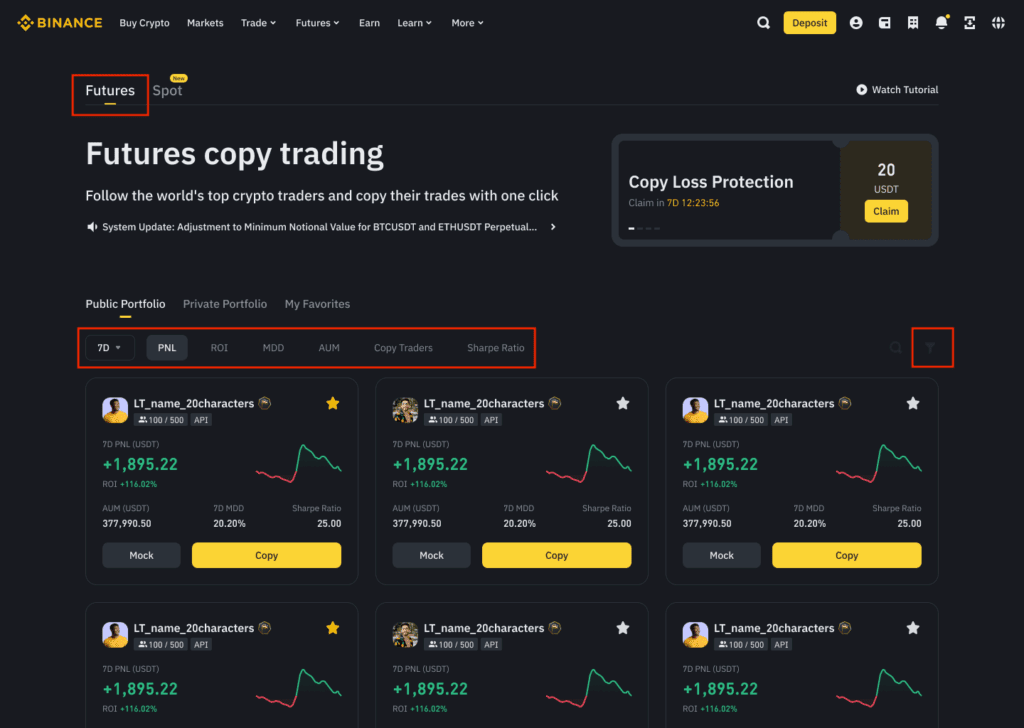
Copy trading attracts those who want to trade cryptocurrencies, but are not ready to spend hours studying charts and news. Experts The Academies of trading note the growing interest of newcomers to the automatic copying of trades by experienced traders, although there are no accurate statistics on the market. The technology allows you to repeat the actions of professionals without deep knowledge of analysis. Platform Pocket Option offers intuitive copy trading functionality with demo account testing. Let’s look at how it works, what the risks are, and how to use the tool correctly.
What is copy trading and how does it work?
Copy trading is an automatic system where your account repeats the trades of a selected trader in real time. It works through software that synchronizes the wizard’s actions with subscribers.
How it happens technically:
- The master trader opens a position on his account.
- The system records the parameters: asset, direction, volume, prices.
- The algorithm transmits data to all subscribers through the exchange infrastructure.
- The same position with a proportional volume is opened on your account.
- When the master closes the deal, your positions are also closed.
Advantages and disadvantages
The main advantages of copy trading:
- You don’t need deep knowledge of technical analysis to get started.
- Save time by not having to monitor the market 24/7.
- You can learn by watching the actions of the pros.
- Diversify by subscribing to different traders.
- Automation eliminates emotions from trading.
- Access to strategies that require constant monitoring.
Important disadvantages:
- Commissions to signal providers eat up part of the profits.
- There are no guarantees of earnings even with successful traders.
- You can get into the unprofitable period of a good master.
- Dependence on other people’s decisions without control over the situation.
- Price slippage worsens the results relative to the master account.
- Technical failures can disrupt the synchronization of positions.
Copy trading does not remove risks — it simply transfers decisions to another person. Past results never guarantee future profits, and market conditions are constantly changing.
How to choose the right trader?

Choosing a master is the most important stage. Analyze not only profitability, but also many other parameters.
Table 1. Key metrics for evaluating a trader
| Parameter | Selection guideline | What does it show |
| Drawdown | Up to 15-20% | Maximum capital drop from peak |
| Sharpe ratio | Above 1.5 | Return-to-risk ratio |
| Win Rate | 50-65% | Percentage of profitable trades |
| Average profit/loss | Above 1.5:1 | Average profit to loss ratio |
| Trading duration | From 6-12 months | Period public history |
Important: these values are heuristic guidelines for primary selection, not a guarantee of success or regulatory requirements.
What to look for when analyzing:
- The equity chart should grow smoothly, without sudden jumps and collapses.
- Trading regularity — too frequent trades may indicate high-cost scalping, too rare trades may indicate the absence of a system.
- A trader works with multiple assets rather than focusing on a single coin.
- Stop losses are visible in the history, which is a sign of risk management.
- Stability of behavior during periods of market volatility and corrections.
- The size of positions does not increase after a series of losses.
Avoid masters who dramatically increase volumes after drawdowns — a classic sign of a lack of discipline and money management. Check how the trader behaved during major market crashes: professionals maintain the system even in a crisis.
Pay attention to the profit distribution: if most of the income is earned in 2-3 trades, and the rest are close to breakeven, this is a red flag. A stable strategy provides a more even distribution of results.
Risks
Copy trading carries specific dangers that need to be understood in advance.
Main risk categories:
- The strategy may stop working when market conditions change.
- Technical failures disrupt the synchronization of positions.
- Slippage — your execution prices are worse than the master’s.
- Lack of liquidity prevents entry at the right price.
- Psychology — the panic shutdown of copying after losses violates the logic of the strategy.
- Dependence on only one trader creates a point of failure.
Table 2. Risk levels of copy trading strategies
| Type of strategy | Average drawdown | Transaction frequency | For whom |
| Conservative | 5-10% | 2-5 per week | Long-term investors |
| Moderate | 10-20% | 5-15 per week | A balanced portfolio |
| Aggressive | 20-40% | 15-50 per week | Experienced with high tolerance |
| Scalping | 15-30% | 50+ per day | Specialists |
Fraud is a particular danger. Some show fake results: they trade on demo accounts, publish statistics only for profitable periods, use several parallel accounts and show results only from profitable ones. Always make sure that the statistics are confirmed by the exchange and are based on real trading.
Regulatory risks also require attention. In 2023, the European Securities and Markets Authority (ESMA) issued guidelines on the supervision of copy trading, classifying it as a regulated service. Different jurisdictions have different restrictions and requirements for risk disclosure.
Parameters for the correct copy trading setup
Settings directly affect safety and results. Incorrect parameters will turn a conservative strategy into a risky gamble.
Key parameters for configuration:
- The size of the copied position is a percentage of the deposit or a fixed amount per transaction.
- Maximum drawdown — automatic shutdown when the loss threshold is reached.
- The copy multiplier is the zoom level relative to the wizard.
- The asset list is an opportunity to exclude certain cryptocurrencies from copying.
- The maximum number of simultaneous positions is the limitation of the total exposure.
- Opening hours — setting up active hours to account for trading sessions.
Practical example: the master has a deposit of $50,000, he opens a position of $5,000 (10% of the capital). You have a deposit of $5,000, the coefficient is set to 0.7. Your position will be: ($5,000 / $50,000) × $5,000 × 0.7 = $350, which is equal to 7% of your deposit instead of 10%. The additional safety margin protects against disproportionate risks.
Risk management rules in settings:
- Do not allocate more than 30% of the deposit to one trader.
- Set the maximum drawdown at 15-20% of the allocated capital.
- Use a copy ratio below 1.0 for additional risk reduction.
- Review the settings at least once a month, taking into account the changes in the results.
- Set up notifications about significant movements for rapid response.
Modes
The platforms offer different modes of operation for different tasks and levels of control.

The main modes of copy trading are:
- Full automatic copying — the system duplicates all the master’s transactions without your participation.
- Semi—automatic mode – you receive notifications about new transactions and confirm their opening manually.
- Delayed copying — positions are opened after a set period of time after the wizard.
- Selective copying — the ability to filter transactions by assets, direction or position size.
- Copy only inputs mode — only position openings are duplicated, you determine the exit from transactions yourself.
- Proportional scaling is an automatic calculation of the volume, taking into account the difference in deposits.
Full automation is popular with beginners, as it does not require constant presence. However, this mode provides maximum dependence on the decisions of the wizard without the ability to quickly respond to a change in the situation. If a trader starts a period of aggressive trading or a drawdown, you will copy all the losing trades.
The semi-automatic mode provides additional control, allowing you to opt out of specific transactions. This is useful during periods of extreme volatility or when you disagree with the direction of the master’s position. The disadvantage is the need for quick decision—making, as a delay in confirmation leads to entry at a lower price.
The selective copy mode is suitable for advanced users who want to combine signals with their own analysis. For example, you can copy only long positions in bitcoin, excluding altcoins or short trades. It is important to understand that selective copying can upset the balance of the wizard’s trading system and worsen the final results.
Exchanges with copy trading functionality
Table 3. Comparison of copy trading platforms
| Exchange | Commission (profit share) | Minimum | Features |
| Bybit | 0-30% | from $100 | Advanced analytics, Pro/Classic modes |
| OKX | up to 30% | from $10 | Low entry threshold, unavailable in UK/US/CA |
| Binance | up to 30% + 10% of fees | from $10-100 | Huge selection of masters |
| BingX | 8-32% | from $50 | Flexible share settings, promo terms |
| Bitget | up to 30% | from $50 | Liquidation protection vouchers |
Important details on exchanges:
Bybit offers a detailed analytics system with an assessment of the stability of the results. The platform uses two copy modes: Classic (basic) and Pro (advanced settings). The commission structure depends on the selected mode and can reach 30% of the profit of the copier.OKX attracts a low entry threshold — you can start copying from $10. An important point: the service is not available to residents of the UK, USA, Canada and several other countries due to regulatory restrictions. Make sure to check availability in your jurisdiction before starting.
Binance provides the largest selection of master traders. In Futures Copy Trading, lead traders can receive up to 30% of subscribers’ profits plus 10% of their trading commissions. High competition among signal providers means a wide range of quality — a thorough analysis is required.

Copy trading review: key indicators of Binance
Bitget has implemented a liquidation protection vouchers program for certain conditions. This reduces the risks of forced closing of positions, but the program has limitations and does not cover all loss scenarios.
Step-by-step instructions for copy trading on Bybit
Bybit is popular in the CIS due to its convenience and wide functionality.
Stage 1. Invoice preparation:
- Register on the platform and complete identity verification (KYC).
- Top up your account with at least $100 to access copy trading.
- Transfer funds to the Derivatives Account — copying only works with futures.
- Enable two-factor authentication for protection.
Stage 2. Choosing a master trader:
- Open the “Copy Trading” section in the main menu.
- Use filters based on ROI, drawdown, and duration of operation.
- Study detailed statistics: equity chart, transaction history, asset allocation.
- Read the reviews of other copiers in the profile comments.
- Choose 2-3 traders with different strategies to diversify.
Step 3. Setting the parameters:
- Click the “Copy” button on the profile of the selected wizard.
- Specify the amount that you are willing to allocate to copy this trader.
- Set a maximum drawdown of 15-20% for auto-stop.
- Select the mode: fixed amount or proportional scaling.
- Set up a list of assets if you want to exclude certain cryptocurrencies.
Stage 4. Launch and monitoring:
- Confirm the settings and activate copying with the “Start Copying” button.
- The system will start duplicating new transactions of the wizard automatically.
- Check “My Copy Trading” regularly to track the results.
- Set up notifications about significant changes in trading.
How is copy trading implemented on Pocket Option
Platform Pocket Option has adapted the functionality of copy trading to the specifics of binary options trading and fast contracts.
Implementation features:
- Social trading is the monitoring of other traders’ trades in real time.
- Demo copy mode – testing strategies on virtual funds without risk.
- Automatic rating of masters based on a variety of performance parameters. Flexible settings from full automation to selective copying of transactions.
- The low entry threshold makes the tool accessible to beginners.
The system uses instant synchronization technology, which is critical for short contracts, where even seconds of delay affect the outcome. Detailed analytics allows you to compare your results with the wizard and evaluate the quality of order execution on your account.
You can combine the copy trading of several masters with your own trades at the same time — this provides maximum flexibility in portfolio management and allows you to experiment with different approaches.
Summarizing: what is important to know when using copy trading
Key principles of successful use:
- Diversification — distribute capital between several masters with different approaches.
- Careful analysis — choose based on long-term statistics rather than current results.
- Risk management — invest only funds that you are willing to accept the loss of.
- Regular monitoring — automation does not mean “start and forget”. Realistic expectations are not passive income or a guarantee of profit.
Copy trading is not a substitute for learning the basics of trading. Even by delegating decisions, you are fully responsible for your investments and must understand the principles of your chosen strategies.
Be sure to test copying on a demo account before making real investments. Evaluate the results for full trading cycles, not after the first losing trades. The master’s past successes do not guarantee future profits — the market is constantly changing, and the strategy that worked three months ago may not work today.
Critical warnings about trading risks
Cryptocurrency copy trading carries an extremely high level of risk and can lead to a complete loss of funds. According to European regulators (ESMA, FCA), 74-89% of retail accounts lose money when trading CFDs using leverage; this statistic is also relevant for leveraged cryptocurrency copy trading.
Financial risks are exacerbated by the extreme volatility of the crypto market. Prices can change by 10-30% in a few hours, leading to rapid and large-scale losses. Even experienced master traders with long-term positive statistics regularly go through significant drawdowns. Price slippage during copying further worsens the results relative to the master’s account, especially during periods of low liquidity.
Psychological risks are especially dangerous in the context of copy trading. The false sense of security from delegating decisions to a professional leads to underestimation of risks and the use of excessive position size. The desire to quickly recoup losses by increasing copied volumes or switching to more aggressive traders leads to catastrophic losses. A panic shutdown of copying at the moment of drawdown fixes losses before a potential recovery of the strategy.
Regulatory risks in the field of cryptocurrencies remain high due to constant changes in legislation. Important: in the countries of the European Economic Area (including Germany) binary options for retail investors are prohibited according to the ESMA decision. Binary options copy trading is not available to residents of the EEA, the UK, the USA and a number of other jurisdictions. Be sure to check the legality of using the selected platform in your country. Do not consider money trading as a way to get rich quickly, solve money problems, or replace basic income. Past results, even long-term and impressive ones, do not guarantee future profits. Any promises of guaranteed income, stable profits, or minimal risks are signs of fraud. Beware of traders who require direct transfers of funds instead of using official copying mechanisms through the exchange.Conclusion
Cryptocurrency copy trading is a complex tool that requires careful analysis, constant training, and strict discipline in risk management. Successful use is possible only with realistic expectations, an understanding of all the dangers and compliance with safety principles.
Platform Pocket Option provides convenient copy trading tools with the ability to test strategies on a demo account before investing real funds. To gain fundamental knowledge about financial markets, technical analysis, and risk management, study educational programs The Academy of Trading, which presents current methods of working with cryptocurrencies and comprehensive capital protection strategies.


